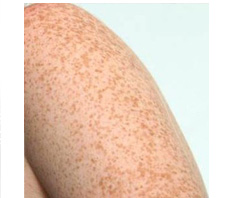







Freckles on arm
Freckle, also called ephelis, plural ephelides, a small,1 to 2 mm, flat, brownish, well-circumscribed, stainlike macular lesions on the skin.
They are much more common in people with a fair complexion and tend to appear on the upper-body skin areas, like the nose, cheeks, arms and shoulders.
Most freckles on a person’s skin are uniform in color, although the shades may vary on different people. They may be yellow, tan, light brown, reddish, brown or black, but they are usually darker than the surrounding skin.
The number of melanocytes does not increase but after exposure to the ultraviolet radiation of sunlight there is an increase in melanin pigment not only in skin melanocytes but in epidermal cells as well and pigmentation usually occurs in basal cell layer of epidermis.
Researchers have isolated a receptor gene (MC1R) and have found that people who have this gene tend to develop freckles. The spots are multiple and may develop randomly on the skin and normally become darker after sun exposure and actually can lighten in the winter months when exposure to sunlight is limited.
They can appear on people as young as 1 or 2 but usually appear after the age of five and tend to fade somewhat in adults.
Most freckles are perfectly harmless and are considered more of a cosmetic annoyance than anything else. Apart from avoiding sunlight, there is no known way of prevention.
>
>
>
>
>
>
>
>
>
>
>
>
>
>
>
>
>
>
>
>
>
>
>
>
>
>
INTRODUCTION
PIGMENTARY DISORDER TYPES
Disorders of
Hyperpigmentation
Disorders of Hypopigmentation
COMMON PIGMENTARY DISORDERS
Age Spots/Liver Spots/Lentigos
Acanthosis Nigricans
Albinism
Cafe-au-Lait Macules
Ephelides (Freckles)
Erythema Dyschromicum Perstans (Ashy Dermatosis)
Familial Racial Periorbital Hyperpigmentation
Idiopathic Guttate Hypomelanosis
Leopard Syndrome
Linea Nigra
Melanoma
Melasma
Nevus (birthmarks/moles)
Parkinsons Disease
Phytophotodermatits
Pityriasis Alba
Poikiloderma of Civatte
Postinflammatory
Hyperpigmentation & Hypopigmantation
Seborrheic Keratoses
Sturge-Weber Syndrome
Substance Induced
Hypermelanosis
Tinea Nigra/Tinea Versicolor/Pityriasis
Versicolor
Vitiligo
Waardenburg Syndrome

<< Previous: Cafe-au-Lait Macules
Next: Erythema Dyschromicum Perstans >>